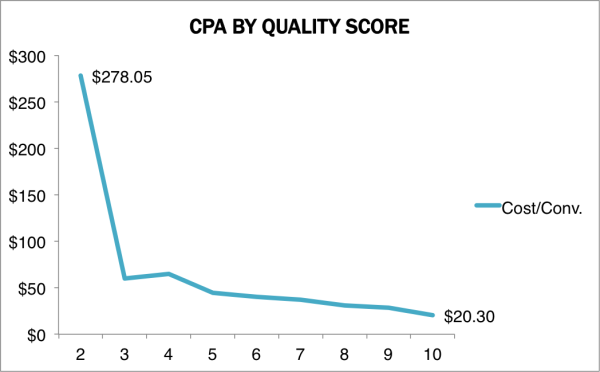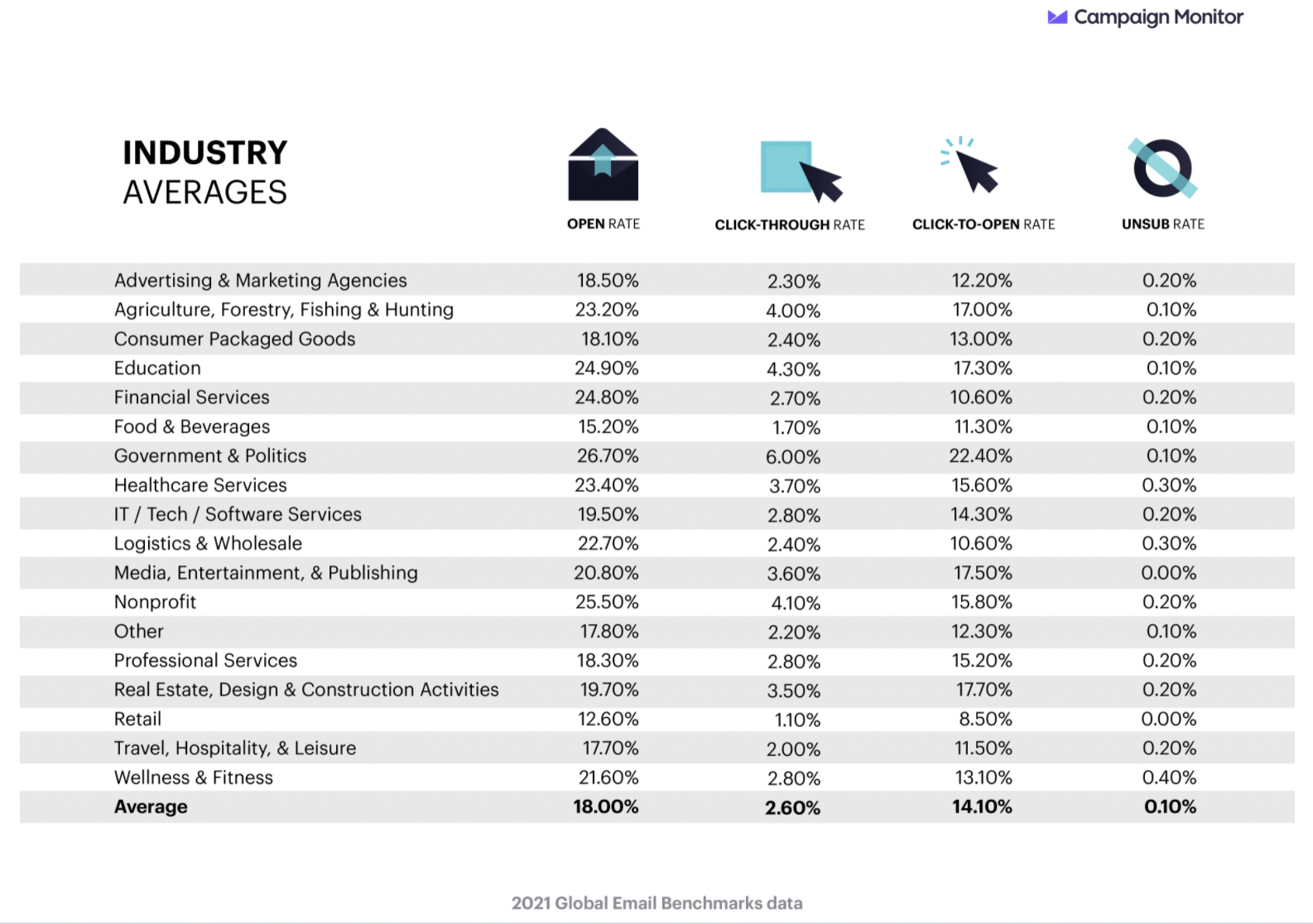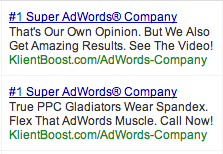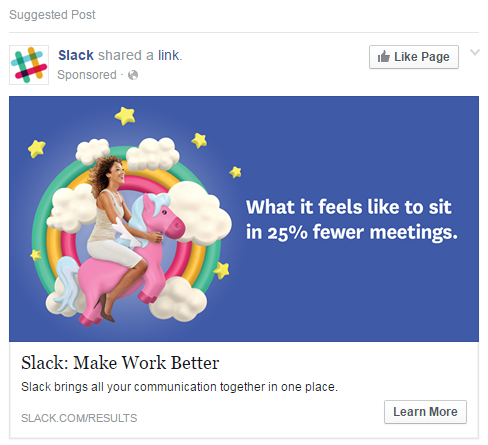Working at a digital marketing company, I put a lot of brainpower into testing how to get someone to click on something. That something is usually a button (also called a Call To Action or CTA).
Sounds so simple.
But it’s not, because it’s not just always a button. My main goal is to get someone to click on a video I’ve made for them embedded in an email I sent to them.
Unsurprisingly, there’s a term for the metric that I spend the majority of my time optimizing: Click-Through Rate (CTR).
Let’s talk about CTR a little a lot, shall we?
Get brand new conversion strategies straight to your inbox every week. 23,739 people already are!
Understanding CTR:
The definition of CTR is “the percentage of people who click on your ad or email link and land on a new destination, such as a landing or product page.” Another way of putting that is “How many people (out of all of the people who saw your thing) clicked on something and went somewhere you wanted them to?”
Where does CTR count?
CTR is measured across multiple platforms, primarily:
- Emails
- Google Display
- Google Search
How to Calculate CTR:
If only there was a “one-size-fits-all” equation. But each platform has different variables so you need to tweak the equation to fit the platform variables.
Like so:
- Facebook CTR Equation: (Total Ad Clicks) / (Total Reach) x 100 = Facebook Click Through Rate
- Email CTR Equation: (Total Clicks on Email Links / (Emails Sent - Bounces) = Email Click Through Rate
- Google CTR Equation: (Total Ad Clicks) / (Total Impressions) x 100 = Google Click Through Rate
All of those equations figure out the same thing: The rate at which your clickable ad or link or button gets clicks.
For example, if 20,000 people saw your ad, and 1,000 people clicked on it, you would first divide 1,000 (number of clicks) by 20,000 (number of people who see it).
(1000 / 20 000) x 100 = 5% CTR
9 Reasons Why is CTR is Super Important
Google Search
1. Affects Quality Score
This is actually one of the main reasons why some marketers really really care about their CTR.
The biggest part of a Quality Score is Click-through-rate (CTR). We did a little digging and found that the Chief Economist at Google, Hal Varian, said that Click-through-rate is responsible for as much as 60% of the Quality Score.
Here’s the deal: if you’re able to improve your CTR, then Google will most likely reward you with a higher Quality Score.
What does that do for you though? I’ll tell you…
2. More Ad Impressions
When your Google Ads Quality Score is higher, it helps you get a higher ad position. And that’s your focus—PPC Ads moving higher in the ranks. Essentially, that’s the prominent real estate space that you get when a searcher searches for something related to your product or service.
The higher the ad rank, the more likely someone searching will see your ad.
Let’s get into why that matters to you.
3. Conversion Rates Go Up
There is definitely a correlation between high CTR’s and high Conversion Rates.
It makes sense: the more people who click on your ad/link, the more likely they’ll hear what you have to say. Therefore, they’re more likely to purchase your product/service.
If you’re able to increase your CTR by 2x, then your conversion rate should increase by 50%.
WHAT?
Yep. And double whooo.
Getting someone interested enough to click on your ad/link is a huge accomplishment, and the excitement that persuaded them to click will contribute to their decision to sign-up and purchase.
[ Pause for applause ]
4. Better Organic Search Rankings
The more your landing pages beat the expected organic CTR for a given position, the more likely you are to appear in prominent organic positions.
Let’s pretend you want to move up by one spot.
For every one position that you want to bump up in Google's SERP (Search Engine Results Page), you need to increase your organic CTR by 3 percent.
Conversely, if your landing page falls below the expected organic search CTR, then your pages will definitely appear in lower organic SERP positions. This is classic search engine optimization (SEO). If your page fails to beat the expected click-through rate for a given position, it's pretty unlikely your page will appear in positions 1–5.
5. Drive more qualified traffic to your website
Once your Quality Score improves, it feels like the world is yours. And it’s like a domino effect:
- First your Quality Score improves.
- Then, your CPC (Cost-per-Click) and minimum bid is reduced.
- Consequently, you’re able to drive more qualified traffic to your website.
6. Reduce your CPC (Cost per Click)
Another blessing that comes with an improved Quality Score that stems from a high Click Through Rate is saving you those dollars.
Here’s the way it works: Google attempts to quantify how much they think you should pay as a minimum to have a keyword show up in a search result. This is based on how Google thinks your ad will contribute to the user experience.
It’s all about that user experience.
If the metrics show that you are contributing toward a good user experience, you will have a low minimum bid. If you aren’t contributing something unique and valuable to the experience, then the result will be a higher minimum bid.
7. Reduce your CPA (Cost per Acquisition)
Allow me to sweeten things up for you even more.
Improving your Quality Score can lower your cost per click, but it can also help you lower your cost per acquisition (CPA).
Which is better, by a lot.
Saving money on each acquisition while also gaining more eyeballs to look at your business (whether it’s LeadGen or Ecommerce) at the same time sounds like a dream, I know.
Email Marketing
8. Higher engagement with your emails (that you’ve worked so hard on)
Email marketers, this one is straightforward.
The more people see your email, the more likely they are to open it. With a high open-rate, there will be a higher click-through rate.
The higher click-through rate means higher engagement. When the engagement rate increases—hooray—the better that is for your business!
If someone engages with your emails you send them regularly, they'll continue to see them. If not, it might get filed away in Gmail's Promotions tab or it may move into Outlook’s Clutter folder or, worst of all, the Spam folder.
Yikes.
When email providers notice that more people are engaging with your emails, it becomes less likely that your emails will end up in those folders.
Facebook Ads
9. Free clicks from Facebook ads
Instead of Google's Quality Score, Facebook has a different term to describe the same thing.
Facebook calls it Relevance Score.
The same benchmark applies: having a higher score results in a higher ad impression share for the same budget at a lower cost per engagement.
That “share” button on Facebook is really neat.
If someone shares one of your boosted posts, that post will show up in another person's news feed and you won't get charged for any of the additional engagements that happen there.
Throw the confetti, Beatrice.
What is a good CTR?
There isn’t one magical number.
It’s hard to compare CTRs across platforms and industries.
But let’s look at some industry averages that can help you benchmark your current CTR against those of your competitors.
Google Average CTR:
Search Ads: The average ad click-through rate on the search network is about 2%.
To put that into perspective, for every 100 impressions of that ad, two users clicked on it. This benchmark indicates that any ads on the search network with a CTR higher than 2% would be considered above-average.
Display Ads The average ad click-through rate on the display network is about .05%.
Ads on the display network have much lower click-through rates because these advertisements are primarily designed to increase brand awareness, rather than drive traffic. In other words, a display ad is meant to pop up a number of times, booping your brain to remember your brand so that, after enough boops, your brand feels familiar. The goal of display advertising is familiarity not conversion. Hence the low CTR for display ads.
Facebook Average CTR:
The average click-through rate of Facebook ads ranges from 0.5% to 1.6%.
The average click-through rate of emails across all industries is about 2.6%.
Those are the reasons why you should work on your click through rate. But how do you actually do that work?
Let’s find out.
8 Ways to Increase CTR
1. Button-Based CTAs > Link-Based CTA’s
Button-based CTAs can increase click-through rate by up to 28% over link-based CTAs.
A Button CTA is what you use in email campaigns that link to somewhere outside of the email, usually to a website or online application.
Research shows that a majority of people scan campaign email rather than reading them word for word.
Good to know, right? Use them visuals.
Use buttons with different shapes and colors for your CTA so it stands out rather than being overlooked.
The clearer the steps are for the reader, the higher the click-through rates.
2. Benefit Focused Copy > Generic Copy
Several A/B tests have been run comparing benefit-focused copy and generic copy. The benefit-focused copy increased click-through rates by about 10%, consistently.
Now, what does that mean exactly?
It means you should swap those generic buttons that say “Read More” or “Buy Now” for something that shows a benefit to the reader. What will they get by clicking through to somewhere from your email?
Try:
- Sneak peek
- Going fast
- Seal your spot
- Only for VIPs
- Limited supply
- Get it first
You get it. The benefit can be urgency, exclusivity, or scarcity. Those things encourage clicks.
3. Placement of your CTA button in the “Terminal Area”
The location that you place your CTA button is crucial.
If you place your CTA button in a spot where your users don’t naturally look, you’re going to lose conversions. Keep it super simple and obvious.
There’s actually an optimal area for the CTA button to be placed, and that’s backed up with research—the Terminal Area.
Where is the “Terminal Area”?
The primary optical area is at the top left, the strong fallow area at the top right, the weak fallow area at the bottom left, and the terminal area at the bottom right.
The user’s eyes naturally begin at the primary optical area and move across and down the display in a series of sweeps to the terminal area.
A button in the terminal area is a compelling call to action because it’s placed at the end of the user’s viewing pattern. It follows the UX principle called recency (the last thing they see is fresh in their mind).
Here’s an example of a CTA button in the terminal area:
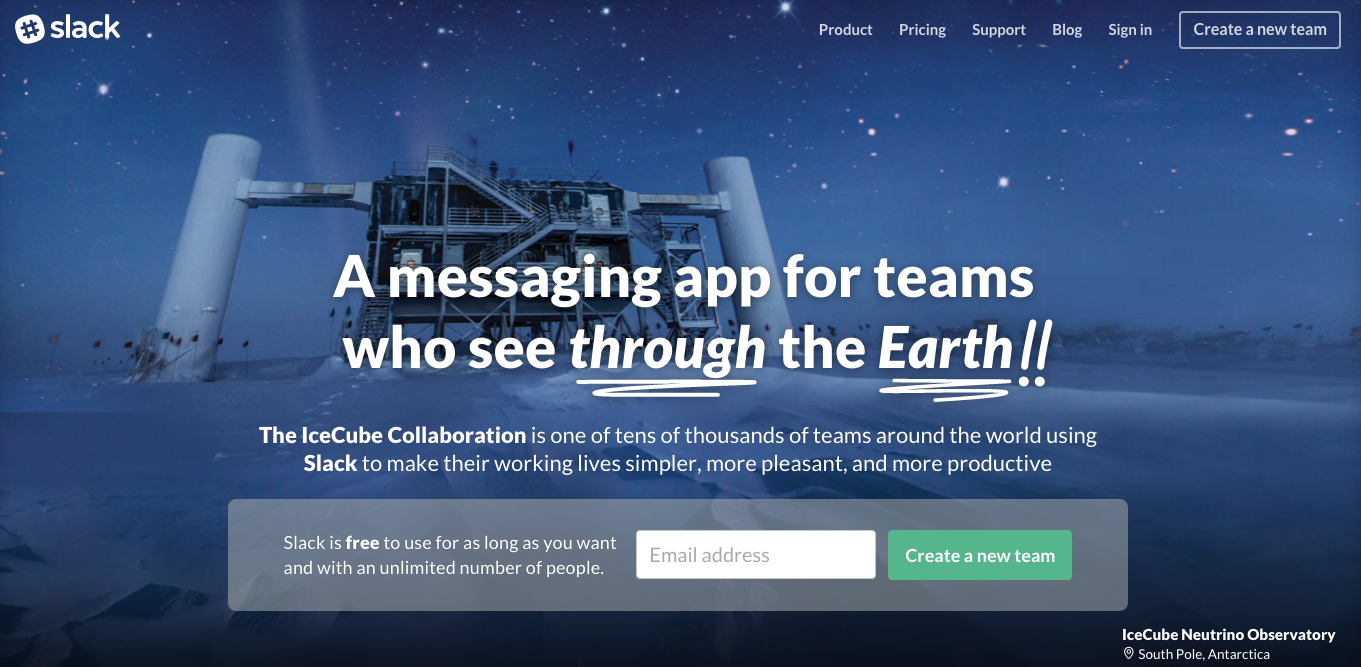
Slack’s call-to-action button is at the bottom right of the page, exactly where the eye falls when it is finished reading the rest of the copy.
Google Ads (formerly Google Adwords)
4. Increasing CTR with targeted messaging
CTR increases when you use ad customizers, inserting details about price and timing into the ad text.
Google’s case study shows that Extra Space Storage was able to increase its CTR by 113%.
How?
Extra Space Storage used ad customizers to reach individual customers with relevant, dynamic ads (inserting details on promotions into their ad text). Specifically, Extra Space Storage tailored its messages in given ad groups. The results were higher engagement with their consumers and higher CTR performance.
Google Analytics displayed the solution to deliver the appropriate message to the target audience. Creating and testing ads at the customer level has yielded a dramatic change for their marketing campaign.
5. Time / Day Affect CTR Rates
It makes sense. The way you open an email on a Monday at 9am is different than on a Friday at 4:59pm. There are so many factors that contribute to whether or not you click-through an email or not.
Google understands that.
Google’s official Quality Score docs show that time of day and day of the week impact CTR, which affects your Quality Score positively or negatively.
If you’re running campaigns 24/7, try splitting up a few campaigns with different time ranges to see if your Quality Scores and cost per clicks are affected. HubSpot does this, suggesting time slots in the morning, midday, and late afternoon when scheduling social posts.
6. Wild Out with your Ads
Ads that are so “out of the ordinary” tend to be much more memorable than the basic ones. I bet you can remember an ad that was so bananas off the top of your head.
We’ve said it before and we’ll say it again:
Make your ad copy so stupid that you think no one will click on it, and then look at the results.
Facebook Ads
7. Use deeper audience targeting measures
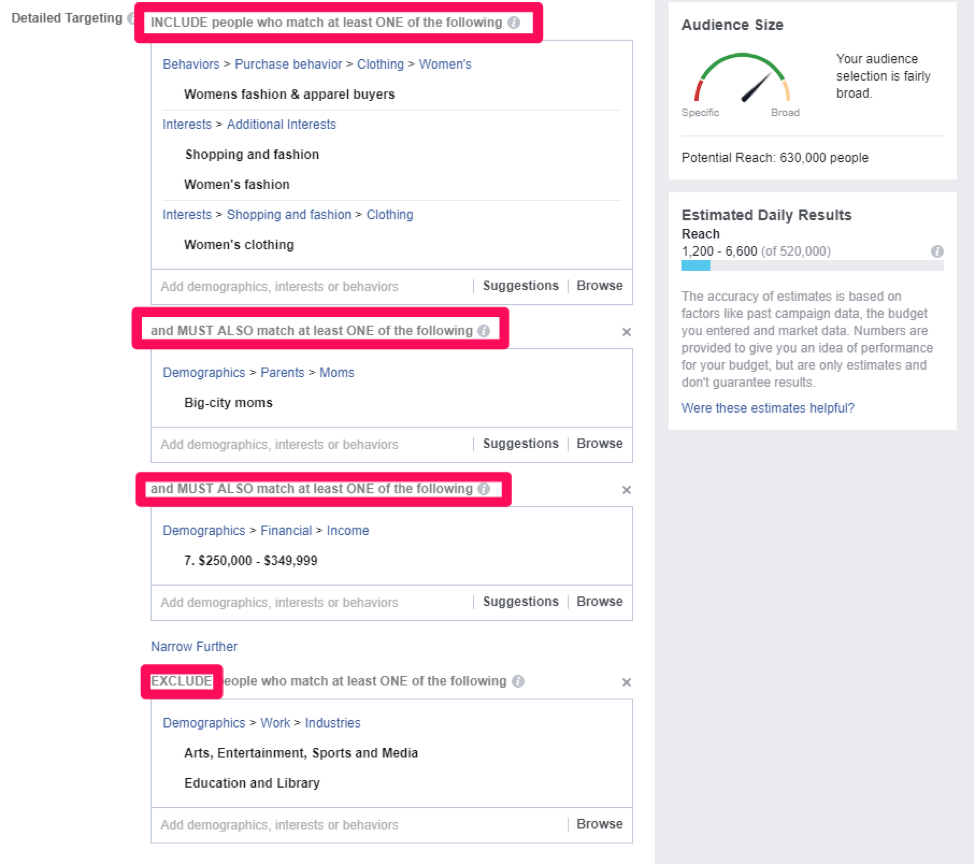
If you aren’t layering interests and exclusions within your audience targeting, you’re targeting way too many people. The key here is to shred it down.
Although the list above has some interests and exclusions, it’s still too big. The list above currently includes 630,000 people.
Think about it.
Would you rather reach 100 people a month and convert half of them or reach 10,000 a month and convert ten people for 3x the cost?
8. Go Crazy with your Ad Copy
Once again, don’t be afraid to be different.
People are lazy and sometimes won’t really take a good look at what they’re sharing. Some headlines are so good people want to share them before anyone else shares them first.
So the goal is to capture their attention.
If you mess up even one line of the ad copy, it could potentially ruin any hopes of the person who is viewing your Facebook ad to share it.
Let’s take a look at a great ad copy example
So...be more creative like Slack.
9. Don’t lose sight of your ultimate goal
It’s very difficult to have successful social media ad copywriting without starting off by defining your goal.
Let’s pretend your Facebook ad campaign goal is to get someone to click on your ad and later on convert. Every single sentence in your ad copy should contribute to that action by nudging the reader towards conversion.
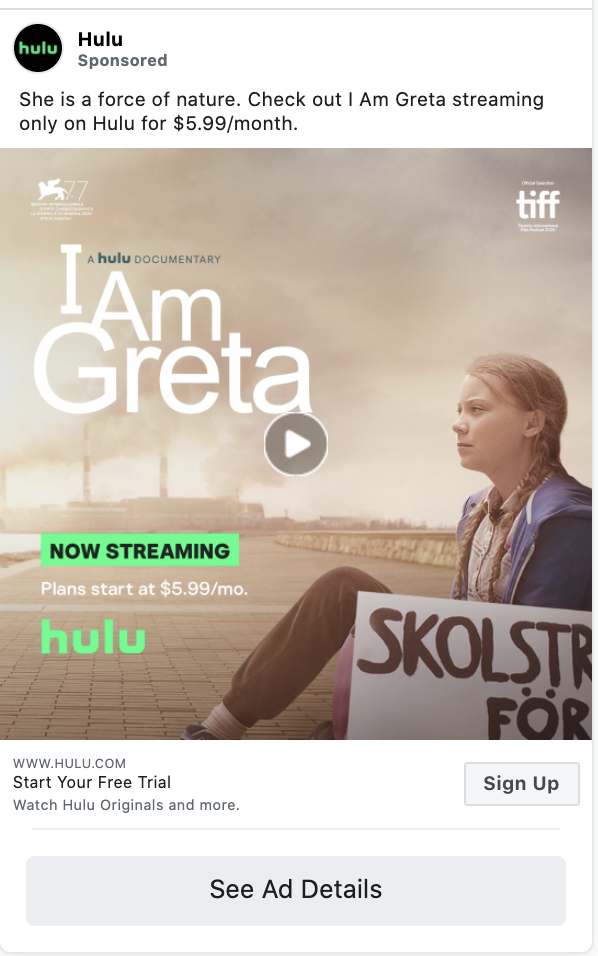
Beyond the Click
We’re curious to hear how often (if ever) you check your CTR’s across FB, Google, and your Email Marketing.
Is it an important metric within your digital marketing strategy?
What’s the click-through rate you strive to get? Is it above or below the industry standard?
These kinds of questions squeeze our juice in the morning.
And if you want to know what comes after optimizing your CTR, the answer is optimizing where those clicks land. Here’s 34 brilliant landing page examples to inspire that part of your marketing journey.

